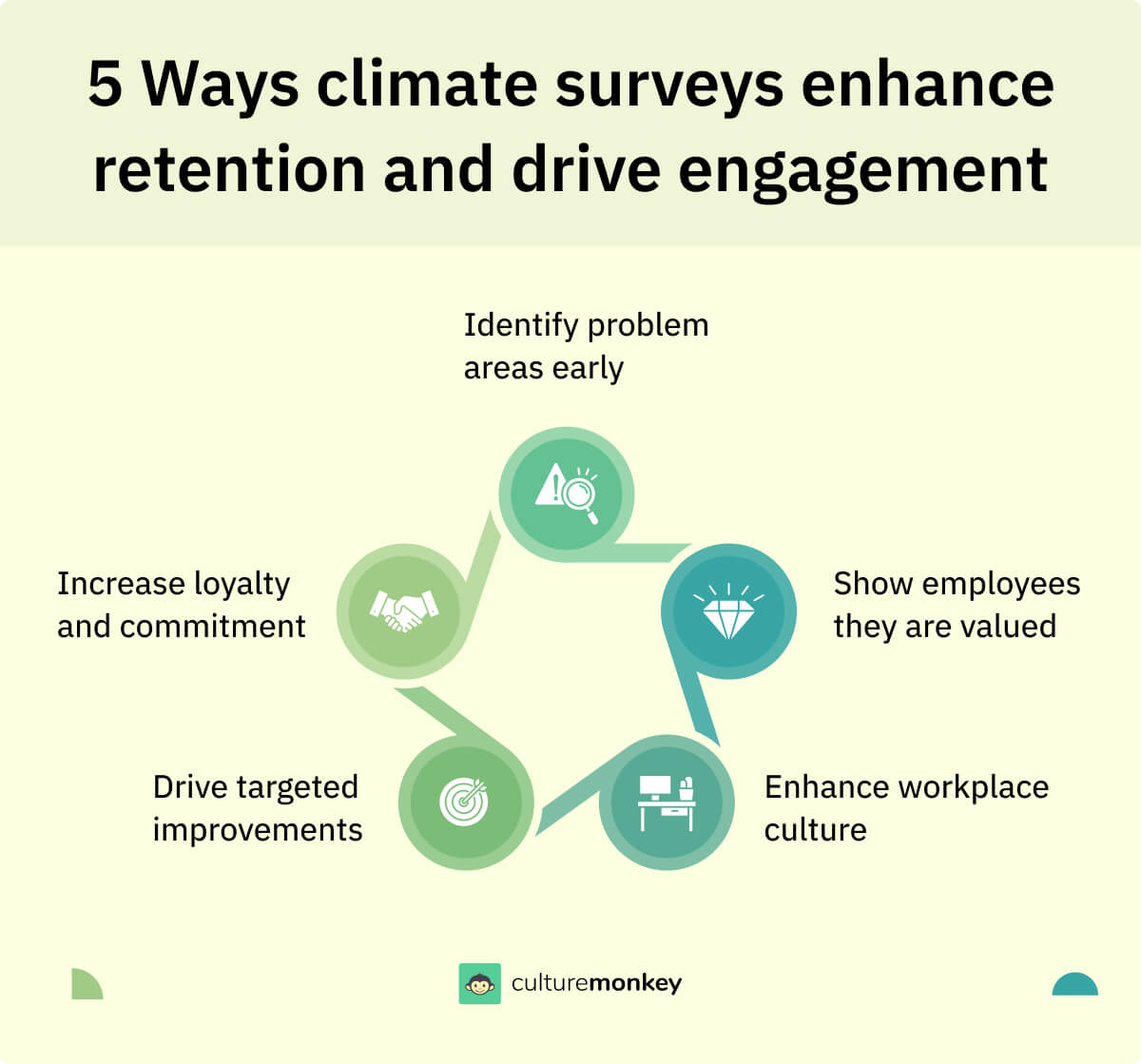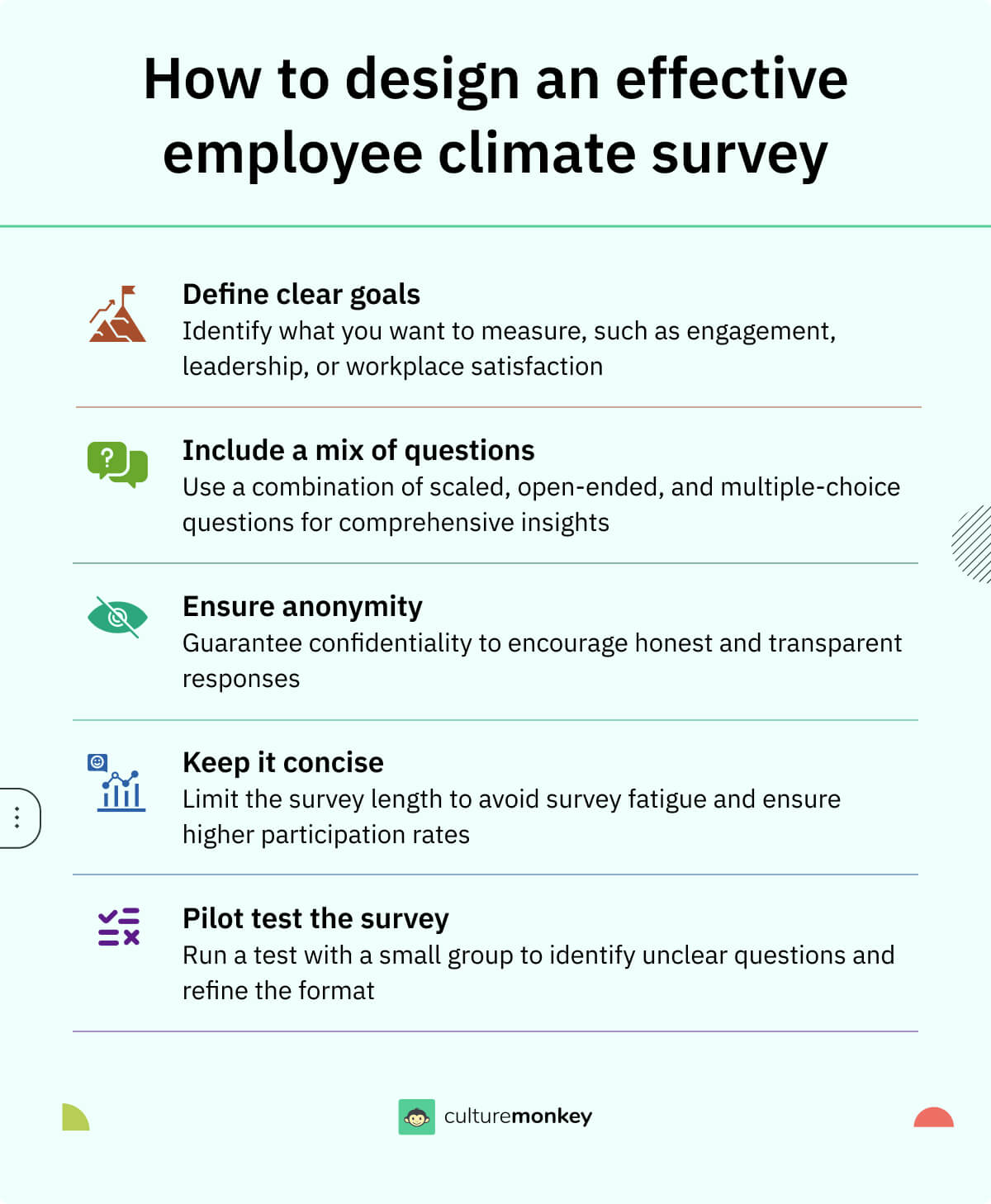Employee climate survey questionnaire: Benefits and best practices to follow in 2025

Imagine this: your company just rolled out a new hybrid work policy, aimed at boosting productivity and improving work-life balance. On paper, it looks like the perfect solution—three days in the office for collaboration, two days remote for focused work.
But weeks later, deadlines are slipping, team morale feels off, and watercooler conversations hint at growing frustration. Some employees feel the commute isn’t worth the office time, while others are struggling to coordinate schedules with their teammates.
What happened? Leadership missed the most crucial insight—the actual experience of employees on the ground. Without their feedback, even the best-intentioned policies can backfire.
This is where an employee climate survey comes in. It’s like a direct line to your team’s thoughts, helping you uncover blind spots, address frustrations, and adapt policies before they spiral into larger issues.
Blog Highlights


What is the employee climate at work?

The employee climate at work, often referred to as the workplace or organizational climate, encapsulates the prevailing atmosphere, attitudes, and overall psychological well-being of employees within a company. It goes beyond the physical environment, encompassing the emotional and social aspects that influence the workplace.
A positive employee climate is characterized by open communication, trust, and mutual respect among co-workers and between employees and management. It promotes job satisfaction, engagement, and a sense of belonging, fostering a conducive environment for productivity and innovation.
Conversely, a negative employee climate is marked by tension, poor communication, and low morale among workers, which can lead to reduced performance, increased turnover, and a decline in overall organizational effectiveness.



Clients do not come first. Employees come first. If you take care of your employees, they will take care of the clients.
Founder
Virgin Group
Why would an organization want an employee climate survey done?
An employee climate survey serves as a strategic tool to uncover valuable insights about the work environment and employee experiences. Organizations benefit greatly from these surveys, as they enable data-driven decisions that strengthen workplace culture and drive business success.
- Identifying organizational blind spots: Employee climate surveys reveal underlying issues or gaps in the work environment that leadership may not be aware of. These hidden challenges, such as ineffective processes or misaligned policies, can be addressed proactively to prevent larger disruptions.
- Enhancing employee engagement and retention: By understanding what motivates employees and what challenges they face, organizations can implement targeted strategies to boost engagement. An engaged workforce is more productive, committed, and less likely to leave the organization.
- Promoting transparency and trust: Conducting a climate survey signals to employees that their opinions are valued. When organizations act on feedback, it builds trust and fosters an environment of open communication.
- Improving leadership effectiveness: Surveys provide direct insights into how leadership is perceived by employees. This allows organizations to identify gaps in leadership effectiveness and implement training or changes to improve managerial support.
- Guiding organizational growth: Climate surveys serve as a diagnostic tool for assessing whether workplace practices align with organizational goals. This ensures the culture and employee experience evolve to meet future business needs.
How do you assess workplace climate?

Assessing workplace climate involves evaluating the overall atmosphere, work culture, and employee experiences within an organization. Here are key methods for an effective evaluation:
- Employee surveys and feedback systems: Conduct regular surveys and establish anonymous feedback channels to measure satisfaction, engagement, and well-being while fostering open communication.
- Leadership assessment: Evaluate leadership styles and accessibility to ensure leaders are supportive, empathetic, and approachable.
- Team dynamics and communication: Observe team interactions and evaluate communication channels to promote collaboration, inclusivity, and transparency.
- Workplace policies and practices: Review policies on diversity, inclusion, flexible work, and employee well-being to ensure they are up-to-date and effective.
- Performance management: Analyze the fairness and transparency of performance evaluation processes to boost morale and recognition.
- Physical work environment and safety: Examine the physical workspace and safety protocols to provide a comfortable and secure environment.
- Retention and turnover analysis: Evaluate retention rates and conduct exit interviews to identify workplace climate issues and areas for improvement.
- External reputation: Monitor employer branding and social media presence to assess external perceptions and the organization’s reputation as a workplace.
Benefits of gauging workplace climate

Assessing workplace climate is essential for fostering a healthy and productive work environment. Here are the key benefits:
- Employee engagement: Understanding workplace climate helps identify factors affecting employee engagement. A positive climate, with open communication and supportive leadership, enhances engagement, leading to increased productivity and job satisfaction.
- Retention and recruitment: Positive workplace climates contribute to employee retention. Organizations prioritizing a healthy environment attract and retain top talent. A positive reputation for a good workplace climate can be a powerful recruitment tool.
- Increased productivity: A favorable climate encourages collaboration, creativity, and a sense of purpose among employees. A motivated workforce is likely to be more productive, contributing to the overall success of the organization.
- Identifying issues: Regular climate assessments unveil potential issues early on, allowing management to address concerns before they escalate. Whether it's communication breakdowns, conflict resolution, or workload management, understanding the climate aids in proactive problem-solving.
- Enhanced communication: Gauging workplace climate involves gathering feedback from employees. This process fosters open communication channels, giving employees a platform to express their opinions, concerns, and ideas. Improved communication builds trust between employees and management.
- Wellness and mental health: A positive workplace climate prioritizes employee well-being. Monitoring the climate enables organizations to identify stressors and implement wellness programs. Addressing mental health concerns contributes to a healthier and more satisfied workforce.
- Innovation and creativity: A supportive climate encourages employees to share ideas and take risks without fear of reprisal. This fosters a culture of innovation and creativity, as employees feel valued and empowered to contribute to the organization's growth.
- Adaptability to change: Organizations with a clear understanding of their workplace climate are better equipped to navigate change. Organizations can implement strategies to ease transitions and maintain morale by knowing how employees perceive changes.
9 Common challenges in conducting an employee climate survey

Below are the 9 common challenges organizations face and how they impact the process:
- Low participation rates: Employees may avoid participating if they perceive the survey as irrelevant, time-consuming, or if they distrust the anonymity of their responses. This results in incomplete or skewed data.
- Survey fatigue: Frequent or lengthy surveys can overwhelm employees, leading to rushed or incomplete responses that compromise the accuracy and quality of the data collected.
- Poorly designed questions: Ambiguous, complex, or leading questions confuse respondents and produce unreliable data. A lack of focus on key topics may also limit the survey’s usefulness.
- Inadequate communication about purpose: Employees may view the survey as a mere formality if its purpose and importance are not clearly explained, reducing engagement and the quality of responses.
- Failure to address results: When organizations fail to act on survey findings, employees lose trust and feel their feedback is ignored, discouraging participation in future surveys.
- Lack of management buy-in: Without leadership support, climate surveys may be poorly executed, deprioritized, or dismissed, reducing their impact on workplace improvements.
- Overgeneralized analysis: Failing to analyze data by demographic groups (e.g., department or tenure) can obscure important patterns and trends, limiting actionable insights.
- Insufficient follow-up process: A lack of follow-up communications or updates on action plans post-survey can make employees feel disengaged and skeptical about the survey's value.
- Unrealistic expectations: Organizations sometimes expect immediate results without accounting for the time required to analyze feedback and implement meaningful changes.
What is a climate survey?

A climate survey, also known as an organizational or HR climate survey, is a tool used to assess employee attitudes, perceptions, and experiences within the workplace. These surveys focus on critical areas like leadership, communication, organizational culture, employee satisfaction, and overall morale.
Typically conducted anonymously to encourage honest feedback, climate surveys use a mix of closed-ended questions (e.g., Likert scales) and open-ended questions to gather both measurable data and deeper insights. This allows organizations to identify strengths, uncover challenges, and understand the reasons behind employees’ perspectives.
The feedback gathered helps organizations make informed, data-driven decisions to improve workplace culture, guide change efforts, and address specific concerns. By conducting climate surveys regularly, companies demonstrate their commitment to employee engagement and creating a positive, supportive environment. This ongoing evaluation ultimately drives employee well-being, productivity, and a healthier workplace culture, ensuring continuous improvement and organizational success.
Employee climate survey: Uses
Employee climate surveys are invaluable tools for organizations aiming to assess and improve workplace dynamics and employee satisfaction. Here are the key uses and benefits of conducting employee climate surveys:
- Measuring employee satisfaction: Climate surveys provide a structured approach to gauge overall employee satisfaction with various aspects of their roles, work environment, and organizational culture. This quantitative data helps identify areas of strength and areas needing improvement.
- Identifying issues and concerns: Climate surveys uncover underlying issues such as communication breakdowns, workload concerns, or dissatisfaction with management practices. By pinpointing these issues early, organizations can take proactive steps to address them before they escalate.
- Promoting open communication: Implementing regular surveys fosters a culture of open communication where employees feel valued and heard. This transparency encourages employees to voice their opinions, concerns, and ideas without fear of reprisal.
- Supporting decision-making: Data from climate surveys provides actionable insights that inform strategic decision-making. Whether it's refining policies, improving benefits, or reallocating resources, organizations can align their actions with employee feedback to drive positive change.
- Monitoring organizational culture: Climate surveys assess the alignment between stated organizational values and actual workplace practices. This helps maintain a positive organizational culture that promotes inclusivity, fairness, and respect among employees.
- Driving continuous improvement: Climate surveys facilitate a cycle of continuous improvement by measuring changes in employee perceptions over time. Trends identified through longitudinal survey data enable organizations to track progress and adjust strategies accordingly.
- Benchmarking and comparison: Climate surveys allow organizations to benchmark their performance against industry standards or competitors. Comparative analysis helps identify areas where the organization excels and areas needing improvement.
- Enhancing employer brand: A positive survey outcome can enhance the organization's employer brand, making it more attractive to prospective employees. Demonstrating a commitment to employee feedback and satisfaction can differentiate the organization in the competitive job market.
- Compliance and risk management: Climate surveys help ensure compliance with legal and regulatory requirements related to employee satisfaction, workplace safety, and fair employment practices. This proactive approach mitigates legal risks and promotes a harmonious work environment.
Models for the preparation of organizational climate survey questions

Below are key models for preparing climate survey questions:
Kirkpatrick’s Four-Level Model
Originally created for training evaluation, this model assesses four levels: employee reactions (e.g., satisfaction), learning (e.g., skill acquisition), behavior changes (e.g., teamwork), and results (e.g., workplace performance). It provides a structured way to connect employee feedback to measurable outcomes. By using this model, organizations can evaluate how employees perceive initiatives and how these impact behavior.
The Job Demands-Resources (JD-R) Model
This model focuses on balancing job demands (e.g., workload, deadlines) and resources (e.g., leadership support, training). Questions based on this model uncover stressors that can lead to burnout or disengagement. It also identifies areas where resources can be optimized to boost productivity. By addressing these imbalances, organizations can create a healthier, more supportive work environment.
Organizational Justice Model
The organizational justice model evaluates perceptions of fairness in workplace rewards, processes, and interpersonal interactions. It includes distributive justice (fair rewards), procedural justice (fair processes), and interactional justice (respect and dignity). Questions based on this model highlight inequities that may harm morale and engagement. T
Competing Values Framework
This model categorizes organizational culture into four areas: clan (collaboration), adhocracy (innovation), market (results-driven), and hierarchy (structured processes). It assesses how employees perceive the company’s dominant culture and its alignment with organizational goals. By analyzing these perceptions, organizations can pinpoint cultural strengths and weaknesses.
Maslow’s Hierarchy of Needs Framework
This model evaluates whether an organization meets employee needs, such as safety, belonging, and self-actualization. Questions explore areas like job security, workplace relationships, and growth opportunities. By addressing unmet needs, organizations can improve morale and motivation. This model ensures that the workplace supports both professional and personal fulfillment.
How do you measure workplace climate?

Measuring workplace climate is essential for organizations seeking to understand the overall health and dynamics of their work environment. A positive workplace climate fosters employee engagement, satisfaction, and productivity, while a negative climate can lead to increased turnover and decreased morale.
Here's why anonymous surveys are considered the best way to measure workplace climate:
- Encourages honest feedback: Anonymity allows employees to express their opinions and concerns candidly without fear of reprisal or judgment. This fosters open and honest communication, providing organizations with valuable insights into the prevailing sentiments within their workforce.
- Minimizes bias: By removing identifying information from survey responses, anonymous surveys help minimize bias and ensure that feedback is based solely on the individual's experiences and perceptions. This allows organizations to obtain a more accurate and representative picture of the workplace climate.
- Increases participation rates: Employees may be more inclined to participate in surveys when they can do so anonymously, as they feel reassured that their responses will remain confidential. Higher participation rates lead to a more comprehensive dataset, enhancing the reliability and validity of the survey results.
- Promotes psychological safety: Anonymity creates a sense of psychological safety, where employees feel comfortable sharing their honest opinions and experiences without fear of repercussions. This fosters trust between employees and management, facilitating more meaningful dialogue and collaboration.
- Facilitates actionable insights: Anonymous survey data allows organizations to identify areas of strength and opportunities for improvement within the workplace climate. Armed with actionable insights, organizations can implement targeted interventions and initiatives to address identified issues and enhance the overall employee experience.
- Pulse surveys: Implement regular pulse surveys to measure real-time fluctuations in the workplace climate. Short, frequent surveys provide quick snapshots of employee sentiments and allow organizations to promptly address emerging issues or trends.
- Qualitative interviews: Conduct qualitative interviews or focus groups with employees to delve deeper into specific aspects of the workplace climate. These interviews allow for richer, nuanced insights that may not be captured through quantitative surveys alone.
- Continuous feedback loops: Implement mechanisms for ongoing feedback collection beyond surveys and interviews. Tools such as suggestion boxes, virtual suggestion platforms, or feedback apps allow employees to provide real-time feedback on various aspects of the workplace climate, fostering a culture of continuous improvement.
- Benchmarking: Compare survey results and qualitative data with industry benchmarks or previous organizational data. Benchmarking helps organizations understand their relative performance and identify areas where they excel or lag, guiding targeted improvement efforts.
How does a staff climate survey differ from other types of employee surveys?
| Aspect | Staff climate survey | Other employee surveys |
|---|---|---|
| Scope and focus | Broad scope, encompassing overall organizational dynamics such as culture, atmosphere, and sentiments. | Narrower focus, targeting specific areas like job satisfaction, engagement, or performance evaluation. |
| Comprehensive assessment | Assesses both individual factors (job satisfaction, recognition) and organizational aspects (communication, leadership, diversity, and inclusion). | Focuses on a single aspect of the employee experience, providing less extensive feedback on organizational culture. |
| Longitudinal perspective | Designed for regular administration to track changes, identify trends, and assess the impact of interventions over time. | Typically conducted on a one-time or ad-hoc basis, lacking a long-term tracking perspective. |
| Holistic insight | Captures both quantitative data (structured questions) and qualitative insights (open-ended feedback) for deeper understanding. | Primarily gathers quantitative data, offering limited insight into the underlying reasons behind responses. |
| Strategic alignment | Aligned with organizational goals to assess the alignment of values, policies, and practices with actual employee experiences. | Often disconnected from broader organizational goals, focusing more on standalone feedback. |
| Areas for improvement | Identifies organizational shortcomings in areas like communication, leadership, and culture, providing actionable insights. | Highlights specific employee concerns but may not address overarching organizational dynamics or trends. |
What are employee climate survey questionnaires?
Employee climate survey questionnaires are tools designed to assess the overall atmosphere, attitudes, and perceptions within an organization. These surveys delve into various aspects of the workplace environment to gauge employee satisfaction, engagement, and well-being.
Employee climate survey questionnaires are valuable tools for organizations to identify areas of improvement, strengthen employee engagement, and foster a positive workplace culture. Regularly conducting these surveys allows organizations to adapt to evolving employee needs and concerns, ultimately contributing to a healthier and more productive work environment.
How do you conduct an employee climate survey at work: 7 Best practices to follow

Employee climate surveys are vital tools for gauging the overall workplace atmosphere, identifying areas for improvement, and making decisions about ensuring employee satisfaction. Here are seven best practices to conduct a successful and insightful employee climate survey:
- Define clear objectives: Clearly outline the survey's purpose. Whether it's to measure job satisfaction, identify communication gaps, or assess leadership effectiveness, a well-defined objective ensures focused and actionable results.
- Ensure anonymity and confidentiality: Establish trust by assuring employees that their responses are anonymous. This encourages open and honest feedback, providing a more accurate reflection of the workplace climate.
- Craft well-designed questions: Formulate clear, specific, and unbiased questions to elicit meaningful responses. Mix quantitative and qualitative questions to gather both statistical data and in-depth insights into employee knowledge and sentiments.
- Use a mix of survey methods: Employ a combination of survey methods, such as online surveys, interviews, or focus groups, to accommodate different preferences and ensure respondents have a comprehensive understanding of the climate.
- Communicate transparently: Communicate the purpose, benefits, and expected outcomes of the survey to employees. Transparency fosters participation and helps employees understand how their input contributes to positive changes in the workplace.
- Regularly conduct surveys: Employee sentiments can change over time. Regularly conduct climate surveys to track trends, assess the impact of implemented changes, and adapt strategies accordingly. This ongoing feedback loop supports continuous improvement.
- Act on survey results: The most critical step is acting on the survey findings. Share the results transparently, acknowledge areas for improvement, and develop action plans collaboratively with employees. This demonstrates a commitment to their well-being and enhances trust in the organization.

What kind of questions do you ask in a workplace climate survey?

- Employee satisfaction and engagement: Focus on understanding how satisfied and motivated employees feel in their roles and with the workplace experience. These questions aim to uncover whether employees feel valued, appreciated, and aligned with the organization's goals.
- Communication effectiveness: Evaluate the clarity, transparency, and efficiency of communication within teams and across departments. Effective communication is crucial for collaboration, productivity, and ensuring employees feel informed about organizational updates.
- Leadership assessment: Assess employees’ perceptions of leadership in terms of support, accessibility, and decision-making. Strong leadership is often a key driver of trust, motivation, and alignment within the organization.
- Professional growth and development: Gauge opportunities for learning, skill-building, and career advancement. These questions assess how well the organization invests in employee development and provides constructive feedback.
- Work-life balance: Analyze whether employees feel supported in managing professional responsibilities alongside personal well-being. This includes examining flexibility in work arrangements and overall organizational support for mental and physical health.
- Diversity, inclusion, and fairness: Examine the organization's approach to promoting a diverse and inclusive environment. These questions also address fairness in policies, practices, and decision-making, ensuring equity for all employees.
- Health and well-being: Assess whether employees feel supported in managing stress and maintaining overall health. This includes access to wellness programs, mental health resources, and workplace safety measures.
- Organizational culture and morale: Understand the workplace atmosphere, team dynamics, and the culture's impact on collaboration, innovation, and belonging. A positive culture directly influences employee retention and satisfaction.
- Feedback opportunities: Identify whether employees feel empowered to share their opinions and whether there are sufficient channels for open dialogue. Constructive feedback processes help build trust and improve organizational practices.
- Overall improvement suggestions: Provide a platform for employees to highlight areas for change and suggest improvements. This fosters engagement by showing employees their input is valued in shaping the workplace environment.
75+ Employee climate survey questionnaire to ask your employees in 2025

Creating an effective employee climate survey is crucial for understanding the pulse of your organization and fostering a positive workplace environment. Here's a set of 75+ well-crafted questions to ask your employees in 2025:
1. How satisfied are you with your current role and responsibilities?
2. On a scale of 1-10, how would you rate the overall work environment?
3. Do you feel your contributions are recognized and appreciated?
4. How would you describe the communication channels within the organization?
5. Are you provided with ample opportunities for professional development?
6. Do you feel your workload is manageable and reasonable?
7. To what extent do you feel your opinions are valued in decision-making processes?
8. How satisfied are you with the work-life balance at our company?
9. Do you believe the company promotes a diverse and inclusive culture?
10. How effective is the feedback and performance review process?
11. Are you aware of the company's mission, vision, and values?
12. How well does your immediate supervisor support your professional growth?
13. Are there clear opportunities for career advancement within the organization?
14. How would you rate the level of collaboration among different teams and departments?
15. Do you feel the company prioritizes employee well-being and mental health?
16. Are you satisfied with the company's benefits and compensation packages?
17. How transparent do you find the communication about changes within the organization?
18. Do you believe there is a strong sense of teamwork among your colleagues?
19. How comfortable do you feel providing feedback to your supervisors and colleagues?
20. To what extent do you think the company encourages innovation and creativity?
21. How well does the company address and resolve conflicts or concerns among employees?
22. Overall, how likely are you to recommend our organization as a great place to work?
23. How supported do you feel in maintaining a healthy work-life integration, including remote work options and flexible scheduling?
24. In what ways do you think the organization can better support employee mental health and well-being, both in the workplace and remotely?
25. How would you rate the effectiveness of internal communication platforms and tools in facilitating collaboration and information sharing among team members?
26. Are there sufficient opportunities for skill development and training tailored to your role?
27. How do you perceive the company's approach to sustainability and corporate social responsibility?
28. Are you satisfied with the level of autonomy and decision-making authority you have in your role?
29. How well does the company foster a culture of continuous learning and improvement?
30. Do you feel that performance evaluations accurately reflect your contributions and achievements?
31. How transparent is the process for career progression and promotions within the organization?
32. How satisfied are you with the physical workspace and amenities provided?
33. Are there adequate resources and support for implementing new ideas and initiatives?
34. How would you rate the effectiveness of team meetings and their impact on productivity?
35. Do you feel that leadership effectively communicates the company's strategic direction and goals?
36. How well does the company support employees during periods of organizational change or restructuring?
37. Are there opportunities for cross-functional collaboration and learning?
38. How well does the company recognize and celebrate employee achievements and milestones?
39. Do you feel that your role aligns with your career aspirations and professional goals?
40. How satisfied are you with the company's efforts to promote work-life balance, including policies on remote work and flexible hours?
41. Are you satisfied with the frequency and format of company-wide communications from senior management?
42. How well does the company handle and respond to employee feedback and suggestions for improvement?
43. Do you believe the company provides adequate opportunities for networking and building professional relationships?
44. How inclusive do you find the company's culture in terms of respecting and valuing diverse perspectives?
45. Are you satisfied with the opportunities for cross-training or gaining experience in different areas of the company?
46. How transparent are the company's policies and practices related to compensation and benefits?
47. How effective are the company's initiatives for promoting employee health and wellness?
48. Do you feel that your workload is aligned with your skills and abilities?
49. How well does the company support employees in maintaining a healthy work-life balance during peak periods or busy seasons?
50. How satisfied are you with the overall leadership and direction provided by senior management?
51. Are you satisfied with the opportunities for professional networking and industry involvement facilitated by the company?
52. How well does the company handle employee grievances and concerns regarding workplace issues?
53. Do you feel that the company fosters a culture of trust and transparency among its employees and leadership?
54.How satisfied are you with the onboarding process when you first joined the company?
55. Do you feel the company provides adequate tools and resources to perform your job effectively?
56. How well does the company encourage and reward high performance and effort?
57. Are you satisfied with the company’s commitment to environmental sustainability and ethical practices?
58. Do you feel empowered to take ownership of projects and make decisions in your role?
59. How would you rate the company’s commitment to diversity, equity, and inclusion initiatives?
60. Are you confident in the organization’s ability to adapt to changes in the industry or market?
61. How effectively does the company communicate updates about policies or procedures?
62. Do you feel safe and secure in your physical workspace or remote work setup?
63. How effectively does the organization celebrate cultural and personal milestones (e.g., holidays, birthdays, anniversaries)?
64. Are there adequate mentorship programs or opportunities for learning from senior colleagues?
65. How satisfied are you with the transparency of the organization’s financial and operational performance?
66. Do you feel the organization supports continuous learning through certifications, courses, or advanced training?
67. Are you satisfied with the company’s social initiatives and community outreach efforts?
68. How well does the company encourage teamwork and collaboration across all levels?
69. Do you feel confident that your concerns or suggestions are taken seriously by management?
70. How comfortable are you with the level of feedback you receive about your job performance?
71. Do you believe the company effectively supports and integrates employees from diverse backgrounds?
72. How well does the company provide clarity on your job expectations and key responsibilities?
73. Do you feel your team is adequately staffed to meet project deadlines and objectives?
74. How satisfied are you with the accessibility and approachability of senior leadership?
75. How satisfied are you with the organization’s efforts to ensure equal opportunities for all employees?
76. Do you feel the company provides sufficient recognition for innovative ideas and creative problem-solving?
77. How well does the organization handle stress management and support employees during high-pressure situations?
78. Are you satisfied with the opportunities to participate in decision-making processes that impact your role or department?

Say goodbye to
employee disengagement
Uncover the questions that matter most—because understanding your employees is the first step toward building a workplace they’ll love.
Workplace climate survey template
Below are essential components to include in a workplace climate survey template:
- Introductory section for purpose and confidentiality: Begin with a brief explanation of the survey’s purpose and assure employees of anonymity to encourage honest feedback. This fosters trust and increases participation.
- Demographic questions for segmented insights: Include questions about department, tenure, job role, and location to identify patterns or trends across different groups without compromising confidentiality.
- Key workplace dimensions: Address areas such as leadership effectiveness, communication clarity, diversity and inclusion, job satisfaction, and work-life balance. Ensure the questions are focused on specific aspects of the employee experience.
- Mix of quantitative and qualitative questions: Use Likert-scale questions to measure satisfaction and agreement levels while incorporating open-ended questions to gain deeper insights and actionable suggestions.
- Customization for organizational goals: Tailor the survey template to align with your company’s strategic objectives, ensuring relevance and a direct connection to actionable outcomes.
- Follow-up commitment: Add a closing note thanking employees for their input and highlighting the organization’s commitment to acting on the feedback received.
How can employees contribute to a positive organizational climate?

Creating a positive organizational climate is a collaborative effort that involves contributions from both management and employees. While leaders play a significant role in shaping the culture of an organization, employees also have a crucial part to play in fostering a supportive and thriving work environment.
Here are several ways in which employees can contribute to a positive organizational climate:
- Embrace open communication: Encouraging open and transparent communication among colleagues fosters trust, enhances collaboration, and reduces misunderstandings. Employees can contribute by actively participating in discussions, sharing their ideas and concerns, and providing constructive feedback to their peers and supervisors.
- Demonstrate respect and empathy: Treating colleagues with respect and empathy creates a welcoming and inclusive atmosphere where everyone feels valued and appreciated. Simple acts of kindness, such as active listening, offering assistance, and acknowledging the contributions of others, contribute to a positive organizational climate.
- Promote teamwork and collaboration: Actively participating in team projects, sharing knowledge and expertise, and offering support to colleagues fosters a sense of camaraderie and teamwork. By working together towards common goals, employees contribute to a positive and cohesive work environment.
- Maintain a positive attitude: Cultivating a positive attitude can have a contagious effect on the workplace, inspiring optimism and motivation among colleagues. Employees can contribute by approaching challenges with a solutions-oriented mindset, staying resilient in the face of adversity, and celebrating successes, both big and small.
- Embrace diversity and inclusion: Valuing and respecting the diverse backgrounds, perspectives, and experiences of colleagues contributes to a more inclusive organizational climate. Employees can contribute by actively promoting diversity and inclusion initiatives, challenging stereotypes, and fostering a culture of acceptance and belonging.
- Take ownership and accountability: Taking ownership of one's responsibilities and holding oneself accountable for their actions fosters a culture of accountability and trust. Employees can contribute by meeting deadlines, delivering high-quality work, and taking initiative to address issues proactively.
- Support organizational values: Aligning individual behaviors and actions with the values and mission of the organization reinforces its cultural identity and strengthens its reputation. Employees can contribute by upholding ethical standards, demonstrating integrity in their interactions, and embodying the core values of the organization in their daily work.
Steps to be taken post a staff climate survey to address the findings

The true measure of the survey's effectiveness lies in the actions taken in response to its findings. Here are a series of proactive steps that organizations should undertake after conducting a staff climate survey to address the identified issues and foster a positive workplace environment.
- Review and analyze results: Begin by thoroughly reviewing and analyzing the survey results. Identify trends, patterns, and areas of concern that emerge from the data. Pay attention to both quantitative metrics and qualitative feedback to gain a comprehensive understanding of the workplace climate.
- Identify priority areas: Prioritize the findings based on their impact and importance to the organization. Identify critical areas requiring immediate attention, such as low employee morale, communication breakdowns, or issues with diversity and inclusion.
- Engage stakeholders: Engage key stakeholders, including senior leadership, managers, and employees, in the process. Share the survey findings transparently and encourage open dialogue to solicit input and perspectives on potential solutions.
- Develop action plans: Collaboratively develop action plans to address the identified issues and improve the workplace climate. Set clear, measurable objectives and outline specific steps, timelines, and responsibilities for implementation.
- Implement interventions: Implement targeted interventions and initiatives to address the identified issues effectively. This may involve implementing training programs, revising policies and procedures, enhancing communication channels, or fostering a more inclusive work environment.
- Communicate progress: Communicate progress and updates on the implementation of action plans to all stakeholders. Maintain transparency throughout the process and solicit ongoing feedback to ensure alignment and effectiveness of interventions.
- Monitor and evaluate: Continuously monitor and evaluate the impact of interventions on the workplace climate. Track key performance indicators, solicit employee feedback, and conduct follow-up surveys to assess progress and identify areas for further improvement.
- Celebrate successes: Celebrate successes and milestones achieved in improving the workplace climate. Recognize and reward individuals and teams for their contributions to fostering a positive work environment.
- Address resistance and challenges: Address any resistance or challenges encountered during the implementation process promptly. Identify root causes, adapt strategies as needed, and provide support and resources to overcome obstacles.
- Commit to continuous improvement: Commit to a culture of continuous improvement by integrating feedback mechanisms and regularly revisiting the staff climate survey process. Encourage ongoing dialogue and engagement to sustain positive changes and drive long-term organizational growth and success.
Role of an employee survey app in conducting climate surveys at work?

An employee survey app plays a pivotal role in conducting climate surveys at work, serving as a dynamic and efficient tool for gauging the overall workplace environment. Here's a breakdown of its crucial role:
- Accessibility and convenience: The app provides a user-friendly platform accessible to employees anytime, anywhere. This accessibility ensures a higher participation rate, leading to more comprehensive and representative data.
- Real-time feedback: An employee survey app enables the administration of climate surveys in real time. This immediacy allows organizations to promptly address emerging concerns, fostering a proactive approach to enhancing workplace satisfaction and addressing issues promptly.
- Anonymous responses: Many employee survey apps offer anonymity features, encouraging honest and open feedback. This anonymity promotes candid responses, crucial for obtaining accurate insights into the actual climate of the workplace.
- Customization and flexibility: These apps often allow organizations to customize surveys based on specific needs. This flexibility ensures that the survey aligns with organizational goals, addressing particular aspects of the work environment, such as leadership effectiveness, team dynamics, or work-life balance.
- Data analysis and reporting: Employee survey apps come equipped with advanced analytics tools. This functionality assists HR professionals and leaders in interpreting survey results effectively. Identifying patterns and trends supports informed decision-making for implementing targeted improvements.
- Engagement and gamification: Some apps incorporate gamification elements to boost employee engagement. Interactive features and gamified surveys can make the process more enjoyable, increasing participation rates and yielding more meaningful data.
- Cost-effectiveness: Conducting climate surveys through an app is often more cost-effective than traditional methods. It eliminates the need for paper, printing, and manual data entry, streamlining the entire survey process.
- Integration with HR systems: Integration capabilities with existing HR systems enhance the overall employee experience. Seamless connectivity ensures that survey data is aligned with broader HR analytics, facilitating a holistic understanding of the workplace climate.
Conclusion
Employee climate surveys stand as a linchpin for the Human Resources department, unraveling the intricacies of a company's success. Beyond mere data collection, these surveys are a bridge between senior management and the workforce, fostering a culture of open communication.
With a well-crafted set of survey questions addressing elements like work schedules and cultural dynamics, organizations can navigate toward a more responsive and employee-centric future.
CultureMonkey plays a pivotal role in simplifying the design and execution of these surveys, ensuring organizations can effectively capture employee feedback on key aspects such as work schedules, cultural dynamics, and leadership impact.
As the pulse of the workforce, climate surveys empower companies to fine-tune strategies, fortify their culture, and ensure a harmonious alignment between employee satisfaction and organizational triumph.
Summary
Employee climate surveys are vital for understanding workplace culture and employee sentiment. By designing effective questionnaires, organizations can gain actionable insights into engagement, leadership, communication, and inclusivity.
These surveys help identify challenges and opportunities, enabling data-driven decisions. When done effectively, they foster transparency, build trust, and create a culture of continuous improvement, leading to enhanced satisfaction, stronger retention, and a more productive workplace.
FAQs
1. What is a staff climate survey, and why is it important for organizations?
A staff climate survey is a tool used by organizations to gather feedback from employees about their perceptions, experiences, and satisfaction levels regarding the workplace environment. Staff climate surveys are important for organizations because they provide valuable insights into employee sentiments, allowing management to identify areas of strength to foster a positive and productive work environment where employees feel valued.
2. How often should organizations conduct staff climate surveys?
The frequency of conducting staff climate surveys can vary depending on the size and needs of the organization. However, it's generally recommended to conduct these surveys at least once a year to ensure that employee feedback is regularly collected and acted upon. Some organizations may choose to conduct surveys more frequently, such as semi-annually or quarterly, especially during periods of significant change or transition in the status quo.
3. Can staff climate surveys help identify potential sources of workplace stress or burnout?
Yes, staff climate surveys can indeed help identify potential sources of workplace stress or burnout. By asking employees about their workload, job demands, work-personal life balance, and overall well-being, organizations can gain insights into areas that may be contributing to stress or burnout. This valuable information allows management to implement targeted interventions and support employees to prevent burnout.
4. How do staff climate surveys help promote employee well-being and mental health in the workplace?
Staff climate surveys play a crucial role in promoting employee well-being and mental health in the workplace by providing a platform for employees to voice their concerns, share their experiences, and provide feedback on factors that impact their overall well-being. By identifying areas of improvement like support systems and workplace culture, organizations can implement initiatives that prioritize employee health and mental well-being.
5. Are staff climate surveys valuable for remote or hybrid work environments?
Yes, staff climate surveys are highly valuable for remote or hybrid work environments. In fact, they may be even more necessary information critical in such settings, where physical distance can create additional challenges in maintaining engagement and communication. Staff climate surveys allow organizations to stay connected with remote or hybrid teams, ensuring that all employees feel included and supported.
6. Who should be involved in creating the survey?
Creating the employee climate survey should involve a collaborative effort between HR professionals, organizational leaders, and employees themselves. HR plays a crucial role in designing questions that accurately capture the employee experience, while input from leaders and employees ensures the survey addresses relevant issues, concerns, perspectives, and insights comprehensively. This inclusive approach enhances the survey's effectiveness in reflecting the diverse viewpoints.
7. How can HR encourage high participation rates in the survey?
HR can encourage high participation rates by emphasizing the importance of employee feedback in shaping the organization's culture and policies. Clear communication about the survey's purpose and benefits, along with assurances of anonymity and confidentiality, can motivate employees to participate. Additionally, providing multiple channels for completing the survey and setting a reasonable deadline can further increase engagement.




